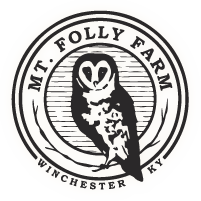February 2, 2021
I just wrote a letter for our Mercantile customers touching on the hours of Zoom farmer meetings I attended in January. Here is my main point:
The main theme… was how to use biology to solve our environmental and health problems. From the gut microbiome to carbon sequestration in agricultural soils, this perspective signals a departure from the reductive and industrial models of health, management, and change.
Rather than building a machine to suck carbon out of the atmosphere at a cost of $600/ton, why not pay farmers to do it for $40/ton? Rather than shooting aerosols into space to block the sun’s rays, why not plant trees and use photosynthesis to take carbon out of the atmosphere? The probable consequences of geoengineering solutions to climate change are (by definition) unintended and too numerous to count. We understand trees; we love trees; and unless one falls on you, trees won’t kill us.
 Here in my farm blog, I want to cover the “How?” and outline further questions.
Here in my farm blog, I want to cover the “How?” and outline further questions.
The paradigm shift involves understanding the farm as a biological system. The main practices making up the biological solution to our environmental problems include cover cropping, management intensive grazing, protecting and enhancing soil biology, particularly with compost and elimination of pesticides and herbicides; reduced tillage, with no-till systems preferable; increased diversity in all its forms, from soil microbes to the soil cash crops and grasses and the cover crops which feed them.
At Mt. Folly, we have instituted all these practices, with organic no-till our weakest link. Organic no-till requires a field implement called a roller/crimper. We took delivery of the roller-crimper in late July, 2020, too late for the planting season. (Custom manufacture of our roller/crimper was delayed because of COVID.) But it is here, and we are ready. This spring we have a field of rye to be rolled down for organic soybeans.
 The cautionary tale is that storing carbon in soils is extremely complex. Whether or not the actual data and computer models are accurate is a question science much answer, as the climate crisis is something we have one chance to fix in the time allowed. By that I mean the tipping points, which lead to large changes in systems, are close in time. The risk of passing these tipping points is great. (This is not an outlandish idea, but one which is accepted by the overwhelming majority of the world’s scientists.)
The cautionary tale is that storing carbon in soils is extremely complex. Whether or not the actual data and computer models are accurate is a question science much answer, as the climate crisis is something we have one chance to fix in the time allowed. By that I mean the tipping points, which lead to large changes in systems, are close in time. The risk of passing these tipping points is great. (This is not an outlandish idea, but one which is accepted by the overwhelming majority of the world’s scientists.)
Thus, from the farm’s point of view, we need scientific confirmation of the effectiveness of our practices.
Changing our lens to the food system, Mt. Folly is a leader in building a local circular economy in our small rural town. We are doing this with a farm-to-table restaurant and a farm-to-bottle distillery. We also are restoring buildings, moving in, and bringing new life to a neglected community.
To see what we are doing and how we are doing, follow @mtfollyfarm on Facebook and Instagram and, if you can, book a stay at the homestead Airbnb.


